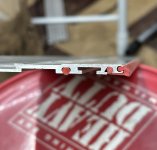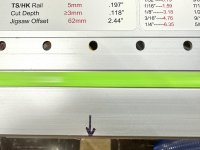ultane said:
Good to know about the Makita strips, as I have already bought several of them to replace the crappy festool ones, that literally fell off while not in use.
...
There is nothing "crappy" about the Festool strips.
They use a different material which is of a way higher quality than the Makita soft rubber. They also use a high quality adhesive that does not degrade over time near as fast.
E.g., our Makita rails already came with a degraded adhesive ... took an inordinate amount of work to clean it when putting the Festool strips on those rails ... (see below why).
The Festool strips are harder which means they work better in their primary function - preventing splinter. But that has a cost - being harder. the material is not elastic-enough to handle well the temperature-related elongation difference between the aluminium rail and the plastic strip. It also means that a teared Festool strip is more impacting the cut quality than, e.g., a teared Makita strip. The soft Makita strips do not work all that well against splinter even when new ... so less difference to a chewed up one. With Festool, a chewed up strip versus a fresh one is a night/day situation.
Overall, I see the Festool strips way superior when used in mostly constant-temp environment where the limitations do not show and the advantages can be leveraged. Not so when stored in a vehicle or an unheated garage (in a colder climate).
IMO, Festool should sell a separate "soft" anti-splinter strip like the Makita ones are for "mobile" storage/use. Till they do, for such harsher climate cases, the Makita strips are the solution.
Caveat emptor:
With the Makita strips the saw cut line should not be farther than 0.1", or so, from the track. The Makita strips being soft and thin, the further from the track the anti-splinter function gets weak to non-existent pretty fast. This is unlike with the Festool strips so can be confusing. Those work well to prevent splinters even with cuts 4-5 mm from the track edge. The easiest this can be seen is with laminated chipboard.
Addo:
Festool did use rubber strips in the past, similar to the Makita copy. They switched to the plastic ones to improve the anti-splinter function I think like 15 yrs ago or so. It was a questionable change for some, but given Makita sells the "old" type that is fine.
Either way, one cannot have an excellent anti-splinter function *and* the advantages of a soft strip *and* the ability of the cut line to be further than 0.1" from the rail. One of the three has to give. Festool chose to forego the advantages of a soft strip. Makita chose to forego the support for a more distant cut line. One can choose the poison.


